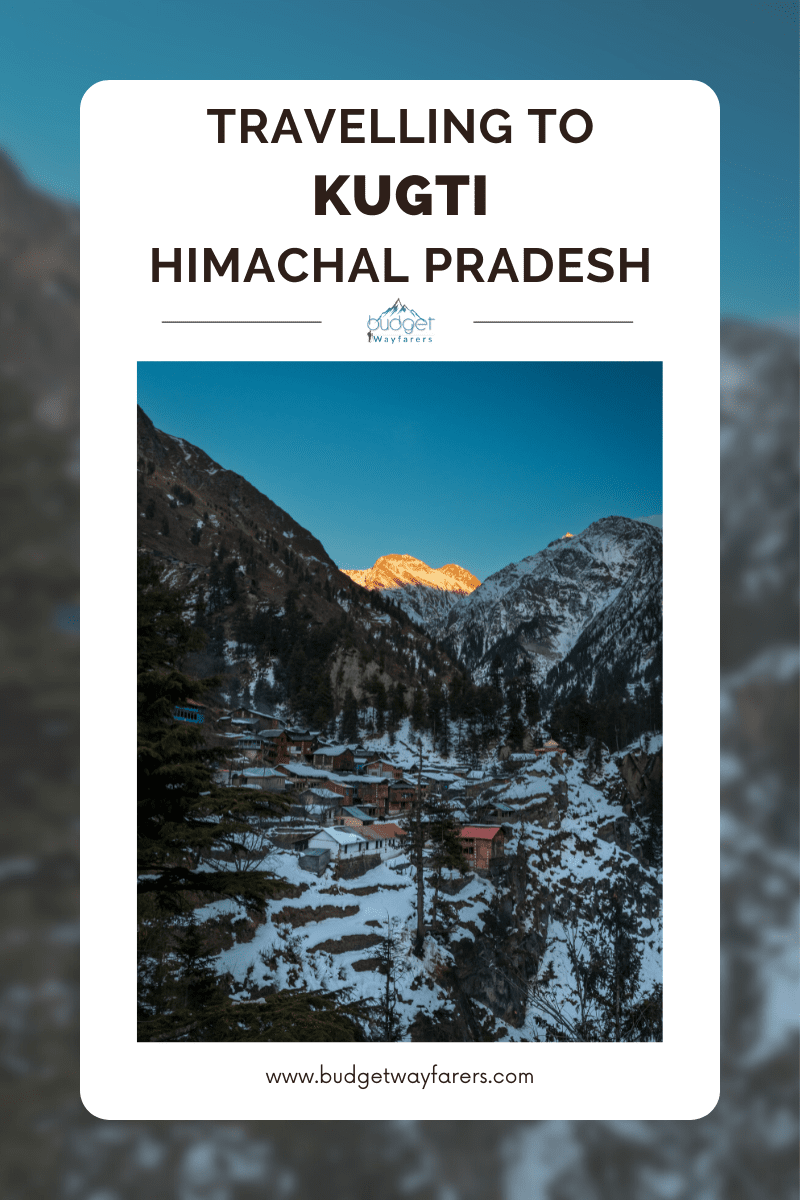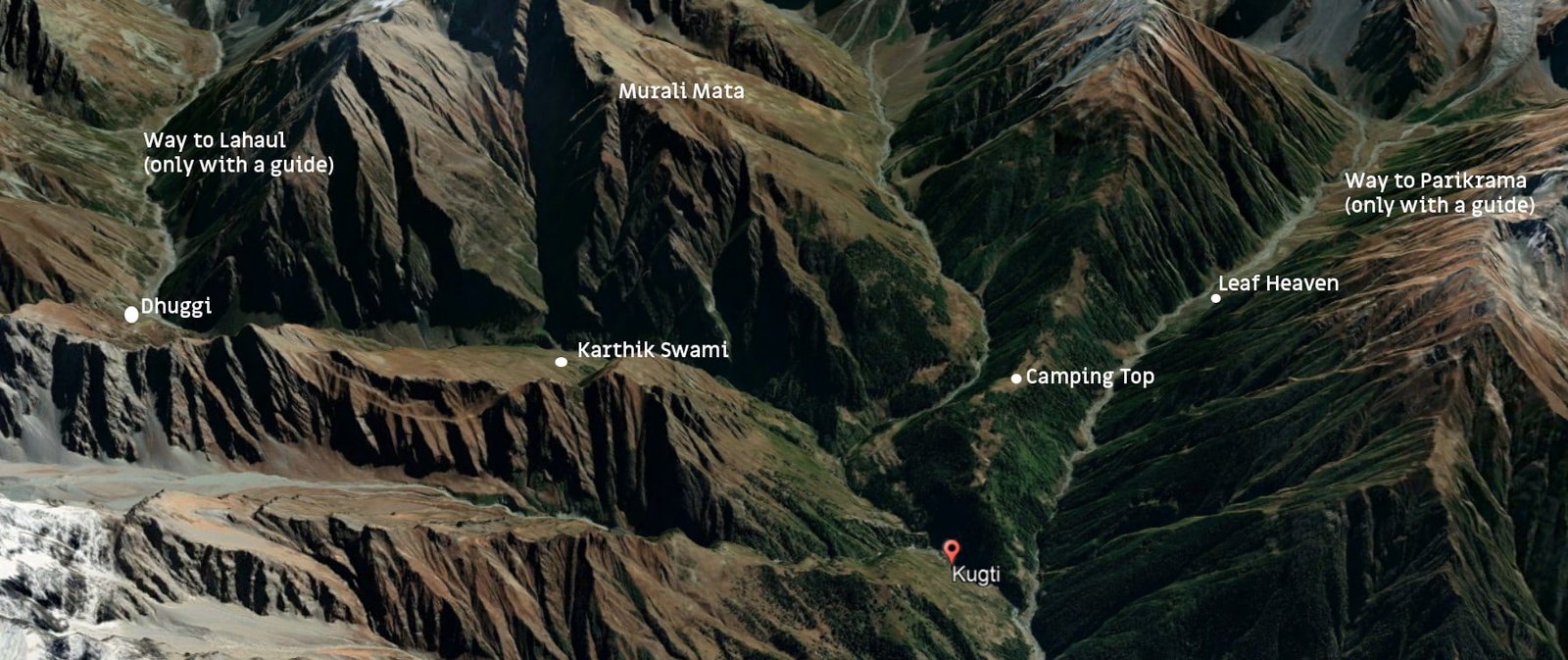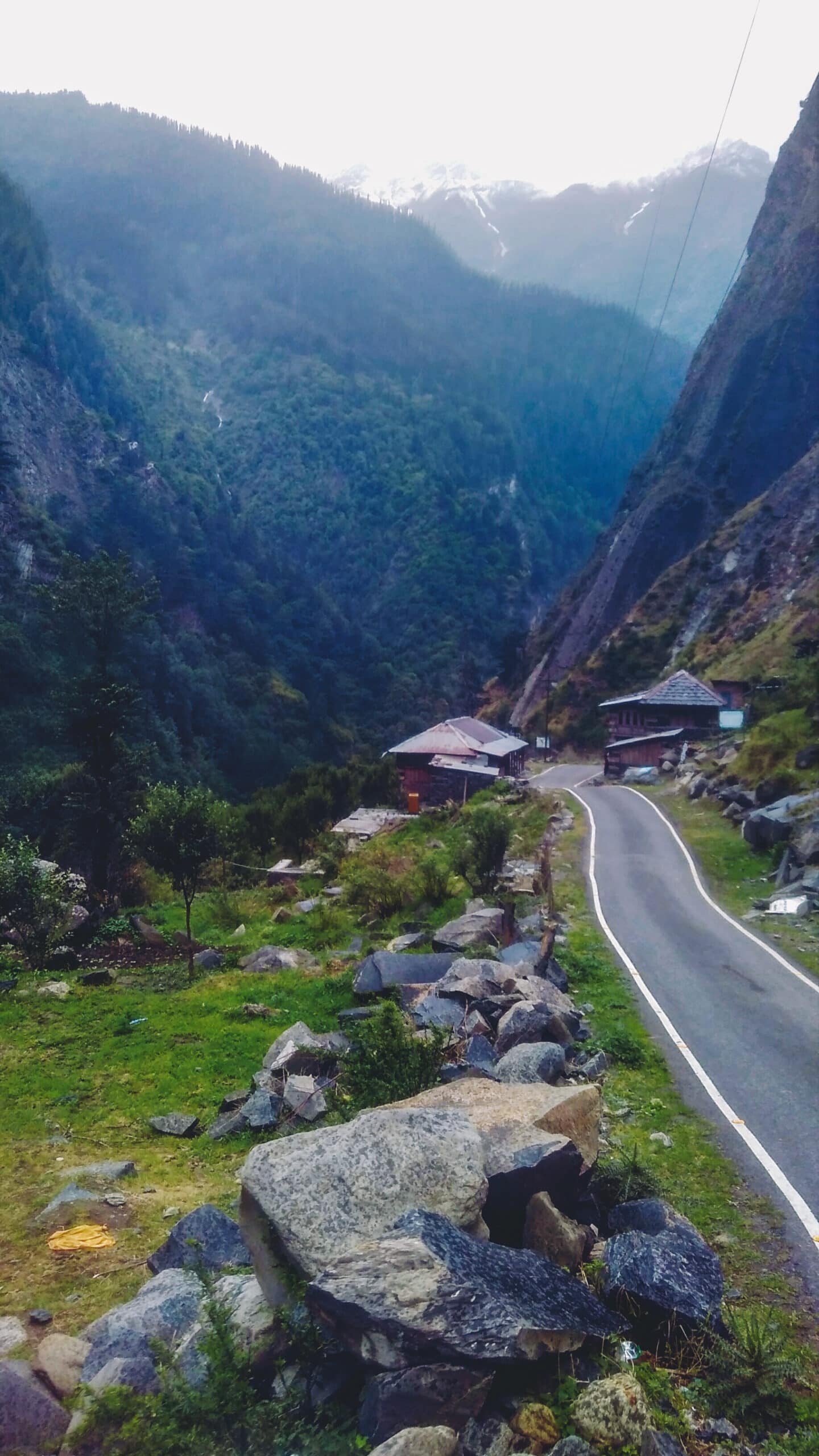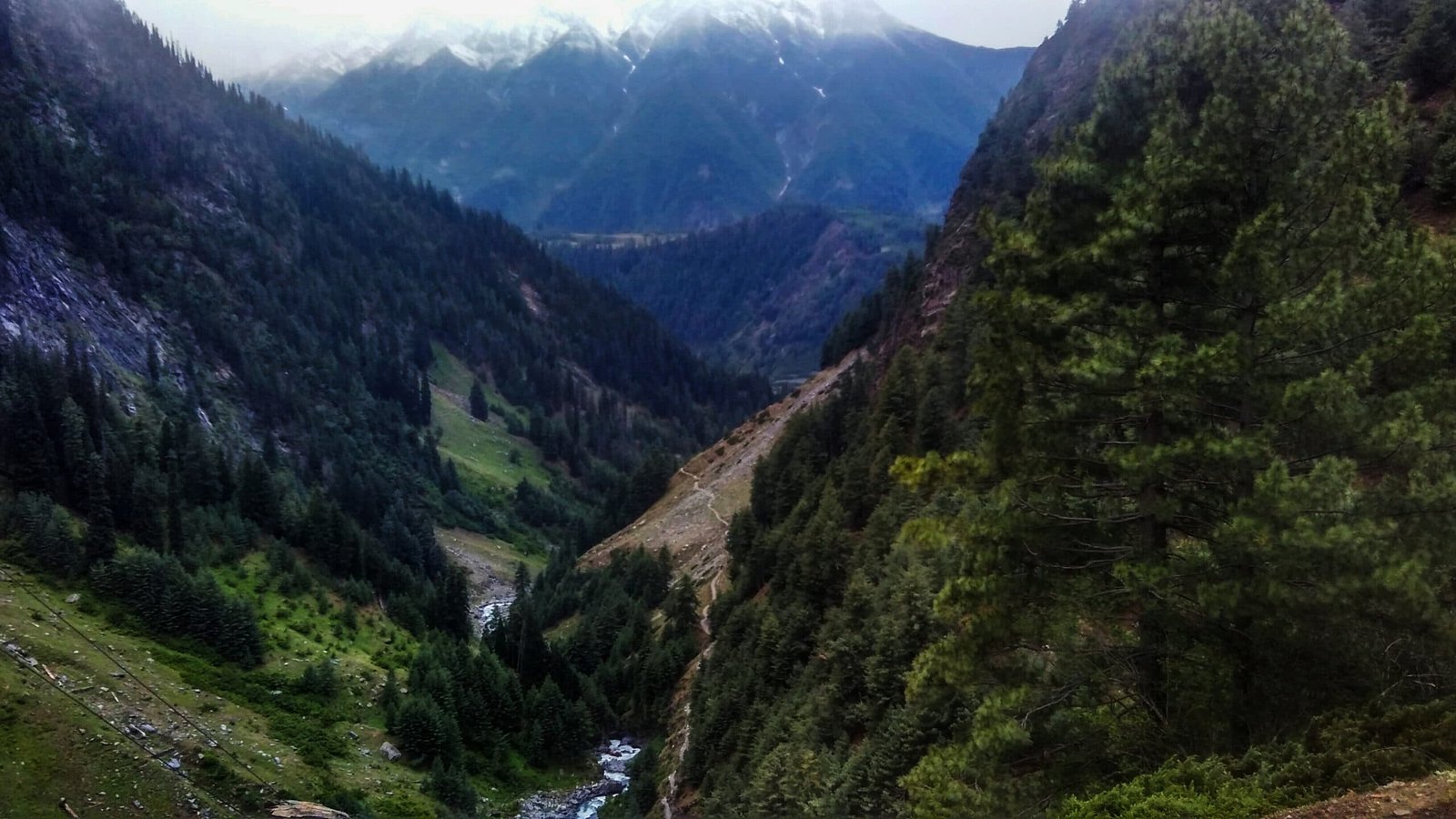I recently visited Kugti and experienced the mystic connection with nature. Through my Kugti travel guide, I will help you plan a visit to this timeless sacred sanctuary.
Kugti, one of the best-kept secrets in Himachal has been hidden away for so long that reaching it now is more of a time travel than a simple vacation. It is a paradise that redefines natural beauty. A land so diverse that it leaves you awe-stuck at every step, and every direction.

Kugti Travel Guide: An Overview
Known to be the Abode of Lord Shiva, Kugti is unlike any other- pure, sacred, and untouched. Apart from the transcendental vibe that is felt here, there are only the immersive sounds of the wind and the flowing river.
Here are a few relevant highlights you must know before planning your Kugti Village trip –
| Location
Chamba, Himachal Pradesh |
| Nearest Town
Bharmour, 25 kms |
| Wildlife
Brown and Black Bears, Snow leopards, Himalayan Tahr, Ibex, Leopards, Goral & more |
| Safety Level
Very High |
| Best Time to Visit
June to October |
| Most Crowded
Late August to early September |
| Altitude for trekking
2195 – 5040 m |
| Preferred Travel
Group |
| Mobile Network
Jio (2g) as per July 2022 |
| Electricity
Kugti – till Karthik Swamy Temple Manimahesh trek– only Hadsar, generators are available in shops and stays, along the trek at night (though voltage is pretty low) |
| Accommodation
Forest and IPH rest houses, Homestays, Camps and dormitories |
| Budget
3000 INR for 4D/3N |
.Let me take you through more details below-

This is the map of Kugti and its surrounding. This will give you an idea of the the nearby places of interest and distances.
Why Should You Visit Kugti?
Everyone is there for a purpose to accomplish, so you might just find yours among the following list
1. Trekking – The treks vary from low to high altitudes, easy to difficult and dense forest areas to no vegetation glaciers, all accessible during summers.
2. Camping – For those who love camping, certainly will find the most picturesque spots to camp in and around Kugti. More of which I’ve explained later, just make sure to keep the fire burning outside the tents.
3. Landscape Photography – You’ll be experiencing the nature as it was centuries ago, the high altitude vegetation of leafy and cushion herbs, valleys of flowers, with narrow creeks, makes shift bridges, and what not. The scenery changes with the weather, as it grows misty or perfectly clear, direct sunlight to is available during evening golden hours. The surroundings here match the landscape wallpaper results from Google. So certainly hope for the next batch of desktop wallpapers from here.
4. Wildlife Photography – You’ll find the rarest wildlife here, specially Himalayan Tahr to which Kugti remains as its last home. There are bears, leopards, ibex, snow leopards, among other which require a little effort and patience, that wildlife photographers are already aware of.
5. Avian Photography – Kugti is home to the rarest avian species, 65% of which are native to this place. A blessing for bird watchers and photographers alike, the surroundings are always filled with the birds chirping which should make it easier, since there are no cars or bikes to be heard.
6. Stargazing – Manimahesh trek has always been my favourite place for stargazing, however Kugti matches it with an even better surroundings with no lights available during the night. The weather does get foggy, though clear skies are generally prevalent.
7. Pilgrimage – This should be the first point, since the place is but a holy land, Lord Shiva is considered to have lived here with his family, so you get it. The temples offer the most panoramic views, with some being at the heights only accessible to some.
8. Finding yourselves – Entire point of this journey is to find yourselves, in the lap of mother nature, away from people & gadgets. This place offers you everything required for self searching, all you need to do is make the choice of finally awarding some-days to yourself.
9. Escape from the world – You’ll be leaving behind everyone, and everything that connects you to the world when you reach here. No mobile or internet connection, no cars, no social media, just you and the pilgrims around you. There are no hotels or hoards of tourists, just some sheep, cows, and some birds in this splendid place, the sight of wildlife is actually a celebration.
10. Adventure – Finally start to trust yourselves by doing what you want to do, challenge yourself to go beyond what you expect from yourselves, have fun and set new limits. Although, always choose not to go to treks, if you can’t walk.
11. Landscape & People – Walking amongst the most delightful of landscapes in Kugti you get excited to see a human or a shop, conversing for hours with strangers both cut from the entire world; where going forward is about trusting yourselves, listening to your heart is easy, and you find yourself alone amongst the high snow peaked mountains, the gushing Budhil stream, spectacular views. The people you meet along the way are likely warriors and saints, dressed as trekkers and shepherds, laughing and dancing as they lead to their destinations.

The journey to Kugti is most scenic of landscapes, surrounded by dense pine and deodar forests, snow-peaked mountains, glaciers, lush green grasslands, countless waterfalls, rivulets, valleys of medicinal herbs and flowers, ancient temples, beautiful treks.
How to Reach Kugti Village?
Bharmour in Chamba is the town where you’ll start your journey. It is where if you haven’t already, shop for all the necessities, go to ATMs, have the luxury of hotels, and book a travel tour guide if you want to trek across to Lahaul.
The town is also the last place to makes calls and use internet, as beyond Bharmour, it is heaven, with shaky mobile network, only BSNL and Airtel (sometimes) works in Hadsar, beyond that its Jio in Kugti. Although you can make important calls, through phones of local people.
Here is a quick overview of the travel details you should know:
| Nearest Airports
Gagghal (Kangra) – 224kms Pathankot- 210 kms |
| Nearest Railway Station
Pathankot – 210 kms |
| Bus Connectivity From Outside Himachal
Volvo available from Delhi/ Chandigarh to Chamba (Dalhousie) |
| Bus Route
Chamba Town to Bharmour – 65kms and Bharmour To Kugti – 25kms Direct Buses to Kugti are available from Chamba and Kangra |
| Bus Timings
Bharmour to Kugti – 11 am, 1:30 pm, 5 pm Kugti to Bharmour – 8 am, 12:30 pm, 3:00 pm |
| Driving
Possible, but remember to drive in within speed limits |
Kugti Travel Guide: Budget Breakdown
| Stay
Bharmour – 700 INR Manimahesh – 300-500 INR Kugti Homestay – 500 INR Dhalotu Camping – 500 INR Karthik Swamy Temple – 100 INR Personal Tents – free (carry sleeping bag resistant to -15 degrees) |
| Food
70 -150 INR full diet, varied by altitude / free during the Manimahesh fair |
| Miscellaneous
Things are expensive in shops amongst the high treks, though it is rightly so, as you’ll find shops even in the most in-hostile regions. |
| Transportation
Bus Fair from Pathankot – Approx 460 INR Bharmour to Kugti – 60 INR Cab – around 1500 INR (can be bargained) Sharing taxis are available during the peak season. |
| Guide Cost
Around 1500 INR for 24 hrs |
What To Do in Kugti – Places to Visit in & Around Kugti
The places to explore in and around Kugti are unlimited, for the adventurous. Let’s take a look at the best places to enjoy your trip to the fullest –
1. Kugti Village
The village is a living monument to our history, with preserved traditions, architecture, and lifestyle that is rarely visible around Himachal. The Khatkuni styled wooden houses, can be seen everywhere, with an ancient Shiva Temple that sits atop a rock. The village is divided in two parts, the Upper and Lower, separated by a waterfall.
The vibe here is refreshing, so roam around the village, click photos, sit in a shop, have chai, maggi, and make friends. People here are very friendly and can guide you a lot about the surroundings and the weather. Homestays are available with food, giving you a chance to experience the village life and know about the ancient tales, the stories of their ancestors and the life before the road.
| Pro tip – Choose the location of your stay depending upon the time of your arrival. You can choose to stay at Karthik Swamy, Dhalotu or Duggi if you reach early or at afternoon. Avoid getting stuck in the wilderness at night. |

Dhalotu, is the base camp for the Parikrama pilgrims, on top of the mountain adjacent to Kugti village.
2. Dhalotu Top
Surrounded by the deodar forests, and the terraced farmsteads, is a grassy top with flowers blooming, that will leave you in love with this place. It offers spell-bounding views of Karthik Swamy trek in front and snow capped mountains of the Kugti wildlife sanctuary at the back.
If you’re warm enough at night and the skies are clear, this is a perfect spot for stargazing. Also since you’ll be accompanied by people going for the Parikrama, some of whom might have walked down from Lahaul or Chamba, have an experience of their tales of adventure and do look at the photos they clicked on their way through. Just don’t get carried away to follow them to Parikrama until you’re sure of yourself, something that is meant only for the experienced.
| Pro tip – When you reach the Dhaltu top, wear a mask and run towards the camps, as the long shrubs around are known to make you dizzy or even unconscious during the day time. |
3. Manimahesh Parikrama Maarg
Parikrama Maarg is a 17 km long trail, circumambulating the Manimahesh Kailash Peak (5653 mtrs, 18,547 ft). It passes through the inhabited lands ranging from coniferous forests, to calm meadows, grasslands, mosses and further glaciers. This sacred journey is filled with a very pure energy of pilgrims and the sacred land, the continuous chants of ‘Jai Bholenath’ are heard everywhere.
This is one of the best journeys you’ll have, even half of it. As you descend from the deodar forests into the rivulet bed, you witness a clear land full of medicinal plants and flowers, separated by a creek that runs from the glaciers situated at the end of this trek. Surrounded by the high altitude vegetation, you’ll be making your way through a narrow trail, that will lead you to the leafy heaven almost 4 kms from Dhalotu. The leaf heaven is a region full of Naag Chhatri leaves, a plant found only in high altitudes considered to be of medicinal value, the entirety of the area full of these, the sacred places of Ganesh Kund, Hanuman Shila and Mata Dham Ghodi are beyond this, among the glaciers.
| Pro tip – Try the Manimahesh Trek from Hadsar first, to check if you can complete the Parikrama or not. Head over to Kamal Kund and a bit further to Kailash Peak, to examine the snowbound glaciers that are to be crossed during the circumambulation. |

Karthik Swamy temple houses, the deity, Karthik, elder son of Lord Shiva, and is visited everyday by a lot of devotees wearing red caps.
4. Karthik Swamy Temple
An easy trek that takes around 1 and half hour takes you to Karthik Swamy temple. A trail that runs between two high mountains, a rivulet flowing in between, a sight to behold and it keeps getting better as you reach the temple.
There is no reason to go fast, go as slow as possible, enjoying the divine beauty you see around. The temple complex is on a steep height, so, avoid slippery trek. Here dormitories are available for sleeping, though that is just a room with a little mattress and a lot of blankets, inside a shop.
Just above that is a small temple requested by the devotees, sister of Lord Karthik, Murali Mata, who is considered as the protector of this land. The temples still follow the ancient practices and rules, something that is of utmost faith to the locals.
| Pro tip – You can charge your power bank and phone here, it is the last place you’ll find electricity. Don’t carry food beyond the temples, if not camping at Duggi (for which you need plastic bags), as you’ll be entering the wild. |
5. Duggi/ Alyas
As you cross the accessible Murali Mata Temple, you’ll be welcomed by large grazing grasslands followed by the pine forests, then descending into the lower grasslands you’ll be walking by the Budhil rivulet completely in wilderness.
The landscape keeps on getting better, as you inch closer the snowy mountains upfront, reaching Duggi – which means deep, a flat grassland where two streams meet and surround the grassland. One and half hours trek from Karthik Swamy, you’ll find yourself in one of the best spots for camping in the wild or just merely enjoying the place.
Bring a guide, if you want to camp here, as they are perfectly aware of the weather changes, how to act around wild animals, food requirements and safety. The guides are joyful local people and will lead you to the best spots around, that are mostly unknown to everyone else. You can always go even beyond, as per your will, depending on the weather, to Alyas or even further with the guide, just be prepared accordingly.
Pro Tip –
|

Manimahesh Trek is a must if you’re visiting this region for the first time.
6. Manimahesh Trek
It is a trek of 13 kms, which starts from Hadsar, and ends with you taking bath in a sacred lake with freezing waters in the presence of most holy Kailash Parvat that watches over you. Although an easy trek, with plenty shelters, shops and a hardened trail, yet it challenges you to your limits if you’re not in the right mindset.
Visited by thousands from across India annually, it is most crowded during the Manimahesh fair, which if you ask me, is certainly a great time to visit, as the vibe is at its best and the people motivate and welcome you at every step. Though toilets become a problem. Anyhow if you’re not fan of crowds you can visit from mid June to late Sept, when the shops are available.
Tip :-
|

Entering Bharmour will leave you enchanted every time, since it is where the green colour starts when you visit from Chamba, after the barren and reddish-yellow mountains you see in the way.
7. Bharmour
Bharmour is a town known for apple orchards and step farming. It gets better as you climb up from the market. It is a beautiful town, situated in between the rivers Ravi and Chenab, though gets traffic jams for hours continuously due to narrow roads.
It houses the famous 84 temple complex, built around 7th century, which is one of a kind and has the Dharamraj Temple, where as per belief, all souls after departing from body, stand and seek the permission of Dharamraj to enter Shiv Loka. There’s also Bharmani Mata temple, that sits on the high ridge, 4.5 kms from Bharmour, having a bath here is considered mandatory before visiting the Manimahesh.
Hotels, restaurants, ATMs, cafes and clothing shops are available here, to provide you enough things for your Kugti adventure.
8. Pro Treks
If you are a pro trekker, then you can go any direction you want to. Hardest treks to Murali Mata Mool Temple (5 kms), Murali Mata Lake (14 kms), Kugti Pass (30 kms), full Kailash Parikrama (17 kms), Chobia Pass (25 kms), even trek to Bara Bhangal, are all open to you.
The land beyond is inhabited, so available for exploration, though you might find the Gaddi’s chilling there with their sheep already.
Things to Carry for Kugti Trip
- Powerbank – carry one with more amperes as the camping generally spellbounds into days at places without electricity. And charge it the first place you see a socket, whether stopped for a chai or chatting.
- Good Raincoat – This will be your best friend here, make sure you have the waterproof lowers too, also carry rain-cover for the backpack.
- Waterproof Shoes – You can get a pair at Bharmour for 250 INR, or get a silicon cover, or carry a lot of pairs of dry socks.
- Best Camera – Since the entire trip is about beauty, you must capture it with the best camera available, DSLR’s are recommended only for professionals who can carry it at the higher altitudes.
- Warm Clothing – get the warmest jacket you have even if you are visiting in June, some waterproof clothing because you’ll be surrounded by snow all the time. Its always snowy there.
- Medicines – bring some paracetamol, and other medicine that you might need in high altitudes.
- Cold cream – for face and lips, it is a must.
- Fire cracker, lighter – Just in case of an unexpected animal encounter, pepper spray is also okay.
- Tent – this is optional, though it is one of the best and cheapest staying option, as you have the choice of staying anywhere you like, though a good sleeping bag is required, also its preferable if you camp near human settlements. The downside is the extra weight.
- Mindfully prepare for Duggi – lighters rarely work on such altitudes, so keep match sticks, a lot of them.. and carefully pack the things as even the smallest thing missed, can lead to entire plan being dismissed.
Kugti Travel Guide: Bonus Tips
- Travel itinerary doesn’t really apply here, all you have to do is listen to your heart, go wherever you want and chill there for as much as you like.
- Must go easy treks are Karthik Swamy, Dhalotu and Manimahesh. Its okay to fall behind the group in them.
- Acclimatization is necessary if you’re visiting directly from hot regions. Chill for a day in Bharmour and take a bath in Bharmani Mata trek, before jumping in the glacial waters beyond.
- Don’t go trekking if you’re not feeling well or can’t walk, find a place to rest and be healthy first. Hospitals are far away, so health should be your priority.
- Local guidance is the key. Stick to their advice, ask from as many people you can. They are generally too encouraging, 1 hour trek for them just might be 2 hours for you, so act accordingly.
- Trust the people here.
- Make sure that you have an extra memory card or enough space in your phone. Deleting photos and videos almost hurts you.
- If the place seems impossible, inaccessible or in dense forests, especially on the Kugti-Hadsar road, don’t become a commando.
- Travel as lightly as possible, carry the best options and prepare for a cold and wet place.
- Don’t carry unnecessary expensive stuff – there is no need for laptops, or iPads since you always should be in a position to leave your heavy stuff in a shop or any local place. Trekking with heavy stuff is no fun, also expensive stuff is just extra weight here.
So, reaching the end of this lengthy Kugti travel guide, I wish you all the best for your journey and hope you find whatever you are seeking.


